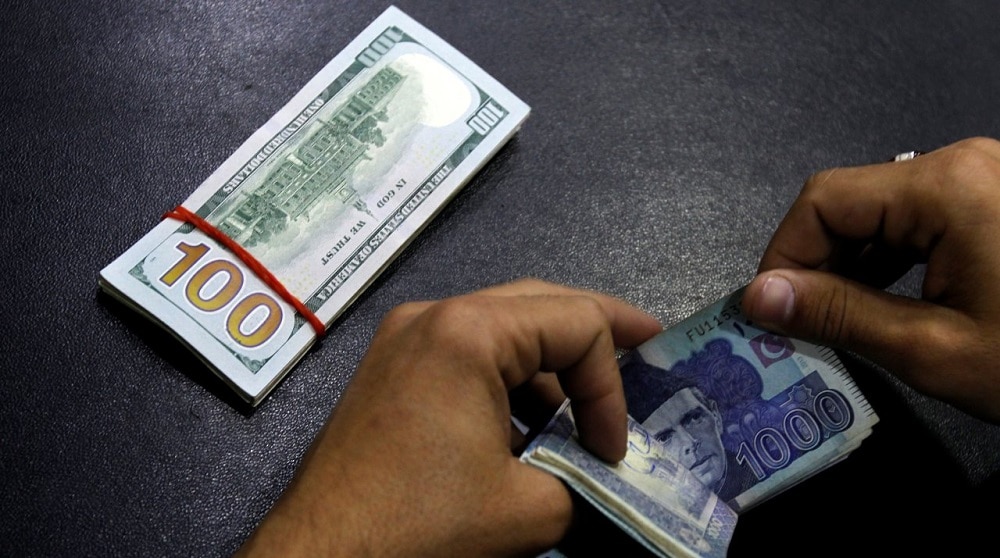PTBP Web Desk
The Pakistani rupee appreciated slightly against the US dollar on Friday morning, reflecting cautious optimism in the country’s foreign exchange market. The local currency strengthened by 0.08% during the opening hours of trading in the inter-bank market, continuing its stable performance amid global financial fluctuations.
At 10 a.m., the rupee was recorded at 280.97 against the greenback, marking a gain of Re0.23. The improvement followed a series of stable trading sessions over the week, suggesting that Pakistan’s monetary and fiscal measures to stabilize the exchange rate are showing positive results.
While the rupee held its ground, major global currencies such as the Japanese yen and euro faced significant pressure. Market analysts noted that Pakistan’s currency movement was relatively muted compared to the volatility seen across international foreign exchange markets.
The Japanese yen was set for its steepest weekly decline in a year, tumbling nearly 4% as investors reassessed the prospects of future interest rate hikes by the Bank of Japan (BoJ). As of early Friday trading in Asian markets, the yen stood at 153.12 per US dollar, hovering near its weakest level since mid-February.
Concerns mounted after comments from Japan’s likely next prime minister, Sanae Takaichi, failed to restore market confidence. Her dovish stance on fiscal policy raised doubts about whether the BoJ would continue tightening its monetary policy this year.
Market analysts warned that if the yen continues to weaken, Japanese authorities may be forced to intervene to curb excessive volatility.
The euro also remained under pressure, trading at $1.15635, close to a two-month low reached on Thursday. The single currency has fallen roughly 1.5% this week—its sharpest drop in nearly 11 months—amid growing political instability in France.
European traders reported that investors have been moving funds into the US dollar, which has benefitted from its safe-haven appeal during periods of geopolitical and financial uncertainty.
The US dollar index, which measures the greenback’s strength against six major currencies, stood at 99.4, near a two-month high. The index is expected to post a 1.7% weekly gain, its biggest in a year, as traders flocked to the dollar amid global market jitters.
According to the CME Group’s FedWatch Tool, investors now anticipate a 95% probability that the Federal Reserve will cut interest rates by 25 basis points (bps) at its upcoming October meeting.
However, expectations for an additional rate cut in December have eased, with odds falling to 80% from 90% earlier in the week. Analysts suggest that the moderation in rate cut expectations indicates that the Fed may adopt a more cautious approach if economic data remains resilient.
The Fed’s policy direction continues to have a direct impact on global currencies, including emerging market units like the Pakistani rupee. A softer dollar typically benefits developing economies, allowing for exchange rate stability and reduced import costs.
In the commodities market, oil prices—a key driver of global currency trends—remained largely steady in early Asian trade on Friday, after declining more than 1% in the previous session.
The decline was attributed to easing geopolitical tensions following reports that Israel and Hamas had agreed to the first phase of a plan to end the conflict in Gaza. The de-escalation of regional hostilities helped reduce the war risk premium that had supported oil prices in recent weeks.
At 0044 GMT, Brent crude futures were trading up 9 cents (0.1%) at $65.31 per barrel, while US West Texas Intermediate (WTI) rose 12 cents (0.2%) to $61.63 per barrel.
Oil prices play a vital role in shaping Pakistan’s foreign exchange dynamics. As an energy-importing nation, fluctuations in crude oil rates directly influence Pakistan’s import bill, trade balance, and inflation outlook.
Economists in Pakistan believe that the rupee’s slight appreciation reflects improved confidence in the country’s external account and better management of foreign reserves by the State Bank of Pakistan (SBP). The central bank has maintained strict control over speculative activity in the currency market, helping curb volatility.
Recent data indicates that Pakistan’s foreign exchange reserves have remained stable, bolstered by continued remittance inflows, exports recovery, and bilateral support from friendly nations. Market watchers, however, caution that global uncertainties—including potential oil price spikes or slower monetary easing in major economies—could still impact local currency stability.
The SBP has also emphasized that its focus remains on maintaining macroeconomic stability and ensuring that exchange rate movements reflect true market fundamentals. A stable rupee, coupled with declining inflation and improved fiscal indicators, could support Pakistan’s broader goal of sustainable economic recovery in the ongoing fiscal year.




